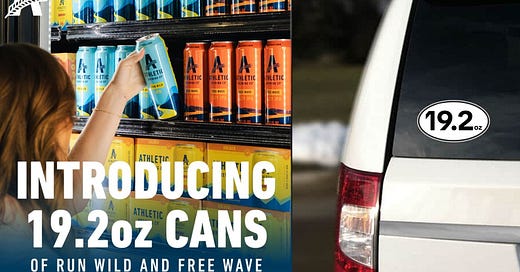In the years leading up to the pandemic, the 19.2-ounce can surged in popularity, creating a unique opportunity for regional craft breweries to establish a presence in gas stations, convenience stores (c-stores), and drugstores. However, with the onset of 2020, this momentum was abruptly halted as shopping habits shifted away from convenience and "on-the-go" channels. Now, as we transition back to normal-ish, convenience is making up for lost time, prompting breweries to prioritize innovation around their shoppers as we head toward 2025. This was certainly the case for us at Revolution Brewing, and it appears to have been a priority for Athletic Brewing as well. But do 19.2-ounce cans of non-alcoholic beer make any sense? Join me for a quickie as I put both sides of the argument to the test.
Athletic deserves recognition for transforming the non-alcoholic beer category that until recently was an afterthought in the U.S.—primarily aimed at recovering alcoholics—into a lifestyle brand. With their explosive growth and category dominance, they have the flexibility to take risks, even if some won’t pan out. I felt similarly skeptical about their May 2023 announcement to partner with JetBlue Airlines as i do with these 19.2s.
I’m a big supporter of the NA movement, but commercial flying didn't strike me as an occasion where NA beer would solve enough of a problem to compel travelers to pay $9, especially when free options like soda, juice, and coffee are available. After a flurry of media coverage during its launch, that partnership ended quietly with Athletic removed from JetBlue menus. While unsuccessful, they were able to find out quickly and learn from the limitations. Will 19.2 ounce cans be any different?
Reason For Skepticism
Although I wouldn’t describe myself as a prototypical c-store shopper, I often find myself stopping at my local 7-Eleven or Circle K to grab a drink. When I do, I’m usually seeking a specific function—whether it’s caffeine or sugar for an energy boost or hydration before heading to a softball game. I’m willing to gamble on brands and flavors since I’m only buying a single. For many, this is also the preferred way to buy alcohol—cold, ready to enjoy, and for a solid value.
Non-alcoholic beer doesn’t seem to fulfill a similar essential function for these convenience-driven purchases, which makes me uncertain about their performance in this market. That doesn’t mean there aren’t people willing to buy them on their way to go hiking, camping, and other outdoor activities, along with other on-the-go occasions I’m not thinking about, but is there enough meat on that bone to warrant the space?
Reasons To Do It Anyways
The 19.2-ounce can format offers a unique size and opportunity for venues, while providing Athletic with a crucial sampling opportunity during experience-driven moments. In markets such as Chicago, many venues prefer the standard 16-ounce can, often avoiding the less consistent 19.2-ounce size to maintain standardization and uniform pricing on their limited menus. With Athletic Brewing’s national reach, there’s likely still enough volume with venues alone to rationalize their distributors carrying the format, the only question is whether their venue partners would prefer and support a 16oz can more. The key with going with the 19.2 though, is that they get to double dip into convenience.
For a top 10 craft brewery like Athletic, which is experiencing impressive growth, the ability to request more shelf placements is a significant advantage, backed by strong data. While I’m skeptical about how well convenience occasions align with NA beer, it would be shortsighted to overlook this crucial growth channel and format. The potential for increased distribution and brand visibility is too valuable to pass up. As their existing grocery partners observe the success in c-stores, the expansion of single-serve sections in this top channel is becoming more pronounced. As Bryan Roth said on LinkedIn,
The beer aisle end cap has changed drastically in the past year. Grocery stores take cues from their convenience counterparts and also have learned about how Americans are shopping post-pandemic, with more store visits for the same number of items. These days, we’re shopping in the moment to find what excites us … and that includes a bigger assortment of single-serve brands that meet whatever our need state may be.
Athletic also has such a lead in NA beer on the craft side of things that from the standpoint of a chain buyer, giving them their 19.2s two spots in the beer cooler gives the category sufficient representation. It’s not like energy drinks (yet) that need multiple coolers to keep up with the endless sea of heavyweight brands and their multitude of flavors. Perhaps short term success for NA beer in convenience doesn’t have to look anything like energy, hydration, or alcohol to be considered a win for Athletic and the chain. It’s a new trial for the company, the chains, and perhaps a number of customers who will grab ‘n go their first ever Athletic can.
This was not my intention when I started writing this, but I’ve talked myself into it 😆









Seems to me that 19.2 cans are about "bang for your buck", i.e. what has the highest ABV at the lowest price point. I've seen several breweries, including ours, launch 19.2s with all the flagship brands, and the only ones that seem to stick are 6%+